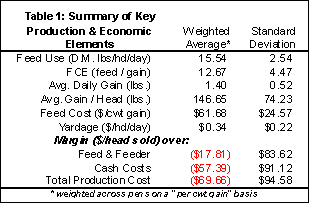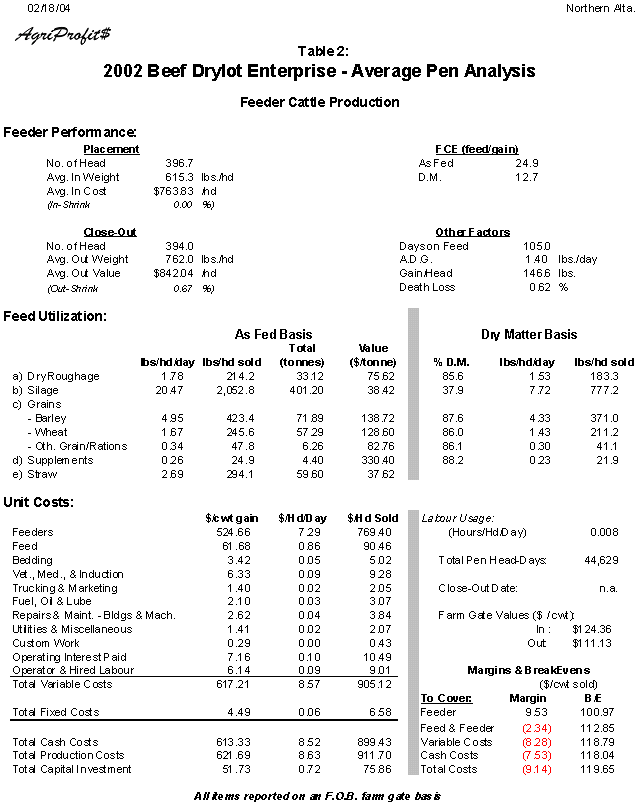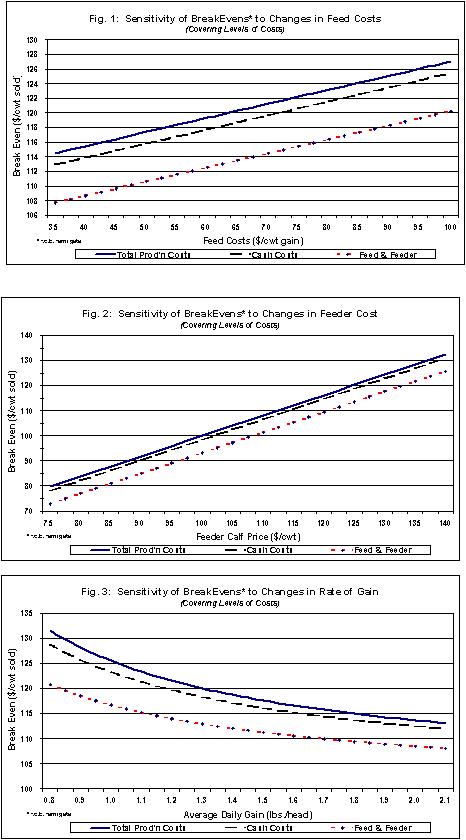| |
 Economics and Competitiveness Economics and Competitiveness
.
Economic & Productive Performance - February 18, 2004
Backgrounding of weaned calves over the winter months is common practice on many northern beef operations, targeting feeder cattle markets through the winter and spring. For years we've believed in the production and business potential for expanded backgrounding of cattle in Northern Alberta but lacked the basic economic analysis information to support this "learned opinion".
In 2003, Alberta Agriculture's Northern Alberta Beef Industry Development Team and AgriProfit$ program staff set out to fill this information gap. The team's broad objective was to "create economic and productivity benchmarks for drylot backgrounding of beef feeder cattle". The following discussions relay the key project findings. The analysis covers a handful of small to intermediate sized operations in the Boreal Transition and Peace Lowland regions in Alberta.
Summary of findings
Key production and economic elements from the analysis of backgrounding pen information is summarized in Table 1. A more detailed "pen average" is presented in Table 2.
- Feed Efficiency: feed use averaged 15.5 lbs of feed dry matter (DM) / head / day with a mean DM feed to gain ratio of 12.7 : 1. Although varied feeding systems and forage sources resulted in reasonable variability in feed conversion, dry matter feed use remained fairly consistent (C.V. in the 16% range).
- Production Efficiency: rate of gain (1.4 lbs/day) and gain per head (146 lbs/head) averages reflect the diversity of feeding systems and stock placed over the course of the 2002 production year. Many pens appeared to have been fed for a lower plane of gain (targeting grass or specific market opportunity).
- Unit Costing: Feed costs comprise the second largest cost element in the profile, after the cost of feeders. Feed costs across the pool averaged $61.68/cwt gain. Relatively high feed input costs and lower plane of gain pressured costs per cwt gain, and increased variability more than expected.

In this analysis, feeds are considered at their market value over the feeding period to assess profitability. From time to time producers may choose to value home grown feeds at their full cost, or even cash cost of production.
An estimate of yardage costs can also be drawn from the analysis. Yardage averaged about $0.34 per head per day across the pool. However, this element ranged from a low in the mid $0.20's to a high just under $1.00 / head / day. This reflects the diversity in feeding systems and facilities employed. Yardage for this type of feeding venture is expected to run in the range of $0.35 to $0.45 per head per day.
- Production Margins: Mean returns over different level of costs show substantial losses to backgrounding cattle over the spring and fall 2002 drylot seasons. As the standard deviations suggest, however, some pens did turn a profit.
Context of analysis & results
The AgriProfit$ analysis represents reasonable case level benchmarks. Profitability in backgrounding cattle is driven by unit operations costs, overheads and timing (feeding to strike a target market window, seasonal and cyclical price movements, and seasonal and weather-related variations in unit feed input costs). Looking back on 2002, timing factors, many of which could not have reasonably been predicted, eventually spelled out losses to the feeding venture. Economic logic suggests long term profit exists in backgrounding feeder cattle.

Information of Strategic Value
The research results highlight the strategic value of costing information to producers. Understanding of one's own unit costs (ie. cost per cwt gain) helps cattle feeders to:
- make adjustments to their operations to gain economic and production efficiencies. A comparison to benchmarks such as these research results is the first step in assessing business strengths and weaknesses.
- use breakevens to define the "feeding package" Given feeder calves of a specific weight, frame and cost, what market could they be targeted to and how can they be cost effectively fed to hit that market.
- employ their costing information, along with market expectations, to assess the risk associated with backgrounding cattle, and if the feeding venture should be strategically taken on at any given time.
- determine the risks and benefits of retaining home-raised calves.
Sensitivity analyses relating breakevens to changes in feed costs, feeder costs and rates of gain are provided in Figures 1 through 3. These highlight the strategic value of costing information in determining if, how and when to background cattle in drylot.
Is there opportunity?
Based on the group average and the associated variability, combined with the knowledge of the feed and cattle markets of the day, it appears that there is certainly opportunity to background cattle in Northern Alberta. The analysis emphasizes, however, that producers feeding cattle in drylot must do so in a planned, strategic manner:
- cost control is a constant, critical element, particularly if backgrounding in drylot is an ongoing activity on the farm.
- overall costing is very sensitive to rates of gain. Feeding at maintenance gains requires a high degree of management control and flexibility.
- if backgrounding is undertaken using home grown feeds, attention must be paid to ensuring losses are not simply transferred from the cattle to the land. The cattle feeding venture must make a positive contribution to the farm's bottom line.

Where to from here?
In future seasons, we'll turn to deepening the backgrounding producer pool to yield more robust and definitive economic analyses, complementing momentum in AgriProfit$ cow/calf information. |
|